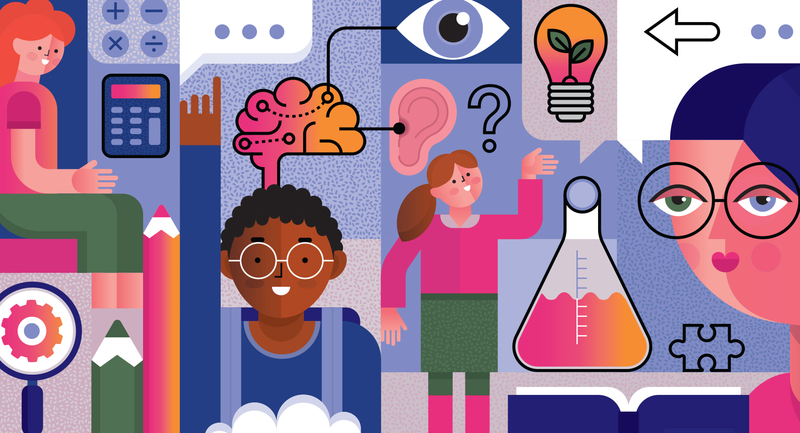Helping students to “pay attention” has always been a central concern of educators. Attention—the ability to focus the mind—is a prerequisite to learning and a basic element in classroom motivation and management. Students who have difficulty concentrating may suffer from seriously disruptive illnesses such as attention deficit disorder and dyslexia.
Further, the design of our brain's attentional system suggests a curricular dilemma. The system evolved to quickly recognize and respond to sudden, dramatic changes that signal physical predatory danger, and to ignore or merely monitor the steady states, subtle differences, and gradual changes that don't carry a sense of immediate alarm. However, schools must now prepare students for a world in which many serious dangers are subtle and gradual: overpopulation, pollution, global warming, acid rain, for example. How do we reset a powerful cognitive system to meet new challenges?
Until recently, cognitive scientists had only a limited understanding of our brain's attentional mechanisms and processes, so educators had to rely on their own practical knowledge. That situation is changing dramatically as scientists unravel the mysteries of how our brain determines what to attend to and what to merely monitor and ignore. Educators must understand the basic mechanisms and processes that regulate attention if we ever expect to make valid and useful educational applications of this significant research development.
Attentional Processes
An effective attentional system must be able to (1) quickly identify and focus on the most important item in a complex environment; (2) sustain attention on its focus while monitoring related information and ignoring other stimuli; (3) access memories that aren't currently active, but that could be relevant to the current focus; and (4) shift attention quickly when important new information arrives.
Some stable elements in our attentional system, which develop early, automatically and predictably reduce the complexity of the surrounding sensory environment. They allow us to quickly respond to sudden threatening events. Other more adaptable elements develop later, and we can teach these adaptable elements to respond to more subtle sensory stimulation, gradual changes, and social demands, such as school procedures. (Ornstein and Ehrlich 1989)
Attention generally begins as a passive process—the brief unfocused reception of the multitude of molecules and rays that continually bombard our body's specialized sensory receptors with information on the outside environment. This period of passive reception is important because it allows our brain to process as many stimuli as possible while it actively searches for anything that might require immediate attention.
But because our brain can't process all this information, stable mechanisms limit input to narrow ranges that contain the potentially most useful information. It's interesting to note that our brain's sensory range differs from those of animals that share our environment. For example, our 10-octave sound range doesn't extend to the higher pitches that dogs hear, and visible light doesn't extend into the lower infrared levels that insects see and that we experience only as heat.
Further, our stable attentional mechanisms are primed to focus automatically on those sensory patterns within these narrow ranges that contain high contrast and/or emotional intensity. Thus, even a passive glance will pick up rapid movements and the lines that define the edges of objects, and a familiar voice will automatically bound out of the babble into our ears.
The external-internal shift. In this active search, our brain frequently shifts its focus between external events and internal memories and interests. For example, while I'm listening to a friend's story, the memory of a related personal experience may suddenly pop up in my mind. I'll usually shift my attention to my own mental story and merely monitor my friend's story while I'm processing mine.
This attentional shift between external and internal events appears to be an important element in maintaining and updating long-term memories, since it ties past experiences to the present situation. Much of our conscious activity involves the deliberate search for cultural experiences (such as TV shows, films, novels, music, trips, conversations with friends) that we know will trigger memories. The recalling and retelling of our memories strengthen the neural networks that contain and process them.
The focus and intensity of active attention can vary widely. Contrast a proofreader and a cursory reader of a magazine article. The first carefully examines individual words and punctuation; the second focuses on the general content. When we consciously seek such specific information, our attentional system primes itself in anticipation. It increases the response levels of the networks that process that information, and it inhibits other networks. Thus, the proofreader scans a page and spots spelling errors, and the cursory reader skims the same page and spots key content words and phrases.
Finding a focus. Our principal attentional activity is the constant conscious selection of a current focus. We must extract what's most important from its context, and then focus on it while we merely monitor the context. The stupid attentional lapses and decisions we make, such as backing our car into a visible post, are a constant reminder that we have yet to achieve perfection in attending to the important and ignoring the unimportant. Emotion obviously dominates reason in many attentional decisions, and a stressful situation can chemically trigger an intense focus on something unimportant—such as when we work on an unimportant task to avoid facing a looming deadline on an important project.
Fortunately, our attentional system provides us with a short-term memory buffer that allows us to hold a few units of information for several minutes while we determine whether to go on to something else or store the data in our long-term memory. The advantage of this limited capacity is that it forces us to constantly select a relatively small focus of attention from a large (and often confusing) sensory field. The disadvantage is that it contributes to our human tendency to make inappropriate snap judgments.
Processing information. Our brain is designed to simultaneously process information from at least two noncompeting stimuli or from different dimensions within the same modality. We can simultaneously observe a friend's face, listen to her talk, and reach for our car keys; but we can't read a novel and write a letter at the same time. We can also increase our ability to divide our attention in some areas. Young children can't carry on a conversation while putting on a coat, but most older children can. An experienced teacher can monitor the specific behavior of more students than a beginning teacher.
Conceptual development increases our attentional span by combining related elements into a single unit. We automatically see a face as a single unit (rather than as individual eye/ear/nose/mouth elements), but readers, who generally focus on individual letters and words initially, have to learn to read entire phrases as single units. The intuition we ascribe to experts in a field may reside in their ability to rapidly size up a situation by identifying relationships among elements that novices don't recognize.
The chemistry of attention. Our ability to maintain attention is affected by normal cyclical fluctuations in the efficacy of the neurotransmitter molecules that chemically regulate attention. These fluctuations occur in 90-minute cycles across the 24 hours. (Hobson 1989, p. 191). People differ in their rhythmic patterns, but at about 6 a.m. many people experience a sharp rise in the availability of these attentional molecules (which causes us to wake up), and the average level of the molecules remains relatively high during the morning. The average levels begin to decline during the afternoon and reach their lowest levels after midnight, when sleep becomes inevitable.
Unexplained curiosities abound—for example, our tendency to doze off around 3 p.m., when we should be awake, and to wake up around 3 a.m., when we should be asleep. Generally, however, we follow our body's predictable rhythms. We tend to do the things that we have to do during the morning, when it's easiest to maintain attention—and things that we want to do in the late afternoon and evening, when it's more difficult to maintain attention without the emotional support of personal interest.
Dysfunctions in attention. Dysfunctional brain mechanisms and/or chemical imbalances can lead to attention deficit disorder (ADD) and other attention-related problems such as retardation and schizophrenia. Although only a small percentage of students suffer from the form of ADD called hyperactivity (Attention Deficit Hyperactivity Disorder, or ADHD), their unfocused, restless, and impulsive school behavior is very disruptive.
It's probable that ADHD emerges at least partly from lower metabolic activity and specific neurotransmitter deficiencies in brainstem and limbic system structures that (1) regulate motor inhibition and control and (2) project into the areas of the frontal lobes that organize and regulate goal-directed attentive behavior.
Properly prescribed stimulant drugs (such as Ritalin™) that increase the availability and activity of our brain's neurotransmitters (catecholamine) seem to inhibit distracting stimuli and impulsive behavior and thus improve the child's ability to attend to appropriate stimuli—to separate foreground from background information and attend to the foreground. The diagnosis and treatment of ADD is still a controversial matter however, because of the drug's side-effects on some children.
Dyslexia is another serious attentional problem that we currently treat with limited success. Dyslexia researchers recently identified a coordination problem in the timing of the visual pathway systems (Livingstone et al. 1991). Our brain processes sensory information through two separate pathway systems: a fast system that processes the background (where objects are located), and a slower system that processes the foreground (what the objects are). The fast visual system of dyslexics appears to be sluggish. Thus, it doesn't erase the previous fixation quickly enough when the eyes move rapidly from word to word in reading, resulting in blurring and fusing words. Lenses that absorb certain light frequencies may be able to improve the coordination, but scientists currently don't know for sure (Livingstone et al. 1991). Similar patterns of sluggishness in the auditory system may cause some auditory attentional problems.
School Practices
Two general guiding principles for classroom management and instruction emerge out of our current knowledge about attention mechanisms and processes. First, teachers should adapt their instruction to the built-in biases and limitations of their students' stable attentional mechanisms. Second, they should use imaginative teaching and management strategies to enhance the development of their students' adaptable attention processes.
The stable mechanisms. Even though the scientific understanding of our attentional system emerged only recently, successful teachers have long grasped the first principle at the practical level. For example, most learn early to do such things as flip the light switch off/on to get their students' attention (since a voice command carries little contrast in a noisy classroom), and to follow a repetitive sedentary activity with something enjoyably active (since interest and pleasure can reverse a currently depressed attentional system).
A more intriguing example of teachers' intuitive grasp of the first principle is the tendency of elementary teachers to schedule individualized skill subjects in the morning, and the less precise, more socially engaging subjects in the afternoon (PE, art, group projects). It makes sense to schedule curricular priorities that require rapt attention and precise response during the morning, when it's easier to maintain attention. It is also logical to schedule interesting activities that demand less precision and sustained attention in the afternoon, when students' inherent interest in the activity will elevate their attention level.
The principal problem teachers face with our attentional system's built-in bias for high contrast, novelty, and emotional overtones is that the curriculum presents a predictable universe: C-A-T always spells cat, and 6 times 5 always equals 30. We want students to solve such problems automatically and unemotionally, but mastery reduces their need to actively attend to the process. The result is that such routine, low-contrast curricular tasks tend to bore the same students who spend hours watching TV, with its emphasis on high-contrast, bizarre, and violent programming, which attracts active attention. It's a dilemma: the effective teaching of skills can reduce students' active attention to the process.
Again, teachers have creatively responded at the practical level through such—sometimes bizarre—behaviors as playing skill mastery games or threatening nonattentive students—in order to artificially increase their students' attention on otherwise unemotional, low-contrast learning tasks. For example, a math relay game is totally unrelated to mastering the multiplication tables. But since such games artificially engender attention-getting excitement through rapid action, teachers have intuitively used them to adapt their instruction to the processing realities of their students' stable attentional mechanisms.
The adaptable processes. Our profession's principal challenge is to help students learn how to consciously manage those adaptable aspects of their attentional system that aren't preprogrammed to enhance survival. In the modern era, human life is more than attending to immediate survival. It is now vital to attend to the quality of our lives and to the potential gradual erosion of that quality.
Our attentional system constantly separates foreground from background and focuses on the foreground. If we don't consciously control the decision about what's important, the system will revert to survival needs—and we end up trampling the beautiful flowers at our feet in a mad dash toward survival. It's important that we teach students how to ignore an insensitive comment that wasn't meant to hurt, how to develop into adults who can appreciate a fine work of art without asking about its cost, how to simply observe a sunset.
The energy released by the plants that surround a rocket launch site is at least as socially meaningful as the energy used to launch the rocket. Although we automatically attend to the televised blast-off, we now have to learn how to attend to the equally important gentle growth of the plants in the background of the televised sequence: that's our curricular challenge.
A brain that can't control its own attentional system can be manipulated into thinking that background is foreground. Recent presidential campaigns have used shrill slogans to force limited but very emotional issues into the foreground, in order to meld more pressing and complicated national problems into the background. The electorate and the media, focused on their own survival, consistently fail to rise up in righteous anger to demand that the candidates reverse the attentional focus.
The Classroom as a Laboratory
Helping students attend to potentially important subtle differences and gradual changes is not an insurmountable challenge: educators have already developed many practical responses to an attentional system we didn't understand. We can expand effectively on what we already know and do. It's mostly a matter of emphasis.
Graphing can teach students how to identify gradual trends. Multicultural programs can celebrate both the unity of the human race and its subtle differences. History can explain how the past gradually became the present. Drama can demonstrate how a simple gesture can communicate what would otherwise take a page of script, and literature can allow us to look behind social facades.
Discussions, debates, and story-telling activities force students to hold bits of information in their minds that they can use to respond to others when their turn comes up. Cooperative learning activities oblige students to attend to others' as well as their own contributions. Simulations, roleplaying, and games require students to compare the real world with a created world. Metaphoric stories and dramas provide only the outlines of the story, forcing students to fill in the personal details. And metacognitive discussions about attention compel students to confront their own thought processes.
The bright, busy classroom environment we've developed, with its 20-plus students and continuous flow of sensory information, forces students to constantly make foreground and background decisions, to attend and respond to events outside and inside their skull. We can use the classroom as a laboratory for student attention research. Good, simple ideas will easily emerge in an exploratory environment that, for example, attends to subtle differences in classification activities and gradual changes in prediction activities.
For example, a teacher may seek classroom analogies to larger population/pollution problems, and then have the class study and discuss them: the gradual build-up of classroom litter, the erosion of privacy in a group, the impact of hostile comments, the shifts in relationships. Before students can help solve such problems in the larger world, they must learn how to solve them in their limited world.
Simple activities such as these don't ensure a world solution to global warming and industrial pollution, but they do help students begin the process of attending to subtle differences and gradual changes. They help to reset our brain from its current built-in focus on the attentional problems of immediate survival to the subtler problems of the present and the foreseeable future.
It's a beginning, and attention is a process that celebrates beginnings.
Brain Systems That Help Determine and Maintain Attention
Neurotransmitters. Norepinephrine and dopamine (two of the catecholamines) appear to be the principal neurotransmitter systems that process attention. Schizophrenia appears to involve excessive catecholamine activity, and some forms of hyperactivity may involve an insufficient number of catecholamines. Attention functions best with an optimum middle level of catecholamines.
Brainstem (or Reptillan Complex). The brainstem passively receives incoming sensory information and starts the process of active attention. The reticular formation and locus coeruleus appear to control arousal and our ability to ignore irrelevant stimuli.
Limbic System. The limbic system provides the emotional overtones and motivation for attention. The amygdala and hippocampus play librarian-like roles in the selection and classification of incoming information for long-term memory storage and retrieval.
Neocortex. The sensory lobes (the back half of the large sheet of neural tissue that makes up the neocortex) process the various forms of sensory information that our brain is attending to, and the frontal lobes control, fixate, and shift our attention—thus consciously determining what's foreground and background and how the current situation refers to our previous experience.
A schematic model of the human brain by Paul MacLean1
1P. MacLean, (1978), “A Mind of Three Minds: Educating the Triune Brain.” In Education and the Brain, edited by J. Chall and A. Mirsky, (Chicago: The National Society for the Study of Education).







